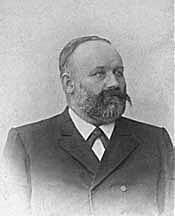 Carl Stoll, 1846-1907. The original designer of the patent overhead trolley system that was to carry his name in all later installations.
Carl Stoll, 1846-1907. The original designer of the patent overhead trolley system that was to carry his name in all later installations.
|
West Ham's First Trolleybus
By John Prentice Part 2 |
 Carl Stoll, 1846-1907. The original designer of the patent overhead trolley system that was to carry his name in all later installations.
Carl Stoll, 1846-1907. The original designer of the patent overhead trolley system that was to carry his name in all later installations.
The Stoll system of overhead current collection was designed by Carl Stoll, a tramcar builder of 56 Leipzigerstraße, Dresden, Germany. His patents for the device date from 1901 and his company constructed a number of small lines, the first being the Haidebahn in Dresden in March 1903. The Stoll design used a trolley with four wheels in two pairs and a vulcanised rubber body, weighing a total of about 12 kg, which ran on the top of a pair of overhead wires 30 cm apart carrying the positive and negative power feeds at 500-550 volt D.C. To keep the trolley level, below was suspended a steel ball weight on a 60 cm long rod forming a pendulum. At commencement of service, using a forked pole, the trolley was lifted onto the wires from the roof of the car, inserting it between the two wires, rotating it through 90 degrees and then lowering it into position.
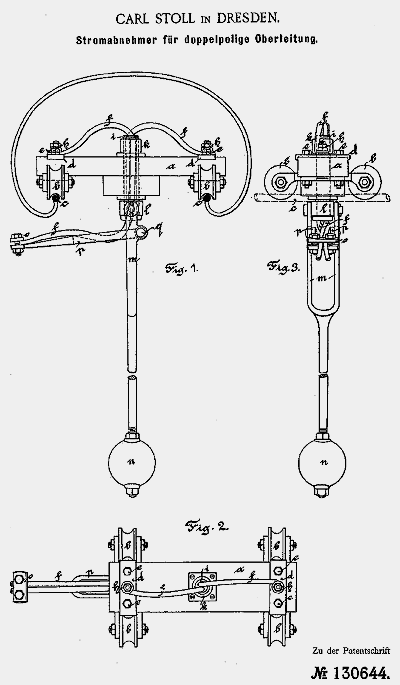
This is the drawing from Carl Stoll's original German patent no. 130644 dated 9th May 1901, showing front elevation (Fig.1), plan (Fig.2) and side elevation (Fig.3) of the "over running" 4-wheel current collecting trolley, which was the unique feature of the system.
The trolley was connected to the vehicle and towed along by a twin flexible cable which had a loop of slack held in tension by a coil spring. The trolley's cable was connected to one on the vehicle by being plugged in with a spring clip fitting which would separate if there was an obstruction. On light traffic routes only one set of overhead was used and cars would unplug and exchange trolleys when they met, a practice followed by many Stoll installations. Under braking or on downhill sections, the trolley would run ahead of the trolleybus, later in Keighley gaining it the nickname "the blind man's dog".
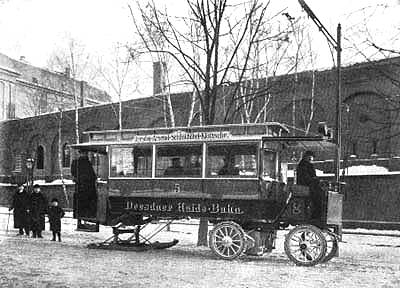
This is Carl Stoll's first trolleybus installation, the Haidebahn in Dresden. The view taken in the winter of 1903/4 shows car 5, built 1903, as an example where the trailing axle, which had larger wheels than the front two axles, has been replaced by skis for a winter service over snow. The two axle driver's tractor unit was detachable from the "trailer" passenger section.
A version of Stoll's trolleybus allowed a trailing rear axle to be replaced by skis in snowy weather, which inspired a promised order from Russia in 1904. However due to the Russo-Japanese war this order was cancelled, forcing the Stoll company into liquidation. Carl Stoll's second son Ludwig transferred what was left of the business to Vienna, Austria. In 1905 and 1906 Ludwig Stoll jointly with Eduard Zelger also of Vienna, patented two devices for controlling the flexible power cable. Sadly in 1907 Carl Stoll took his own life.
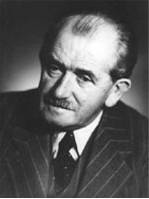 Ferdinand Porsche, 1875-1951, who together with Ludwig Lohner designed the hub motor used in the Cedes-Stoll trolleybuses. In 1928 as Technical Director of Daimler he developed the Mercedes SS and SSK supercharged sports cars, in 1931 founded Porsche Engineering and in 1936 created the Volkswagen.
Ferdinand Porsche, 1875-1951, who together with Ludwig Lohner designed the hub motor used in the Cedes-Stoll trolleybuses. In 1928 as Technical Director of Daimler he developed the Mercedes SS and SSK supercharged sports cars, in 1931 founded Porsche Engineering and in 1936 created the Volkswagen.
Meanwhile at Jakob Lohner & Co. in Floridsdorf, Vienna in 1902 Ludwig Lohner, a coachbuilder and Ferdinand Porsche an engineer (later of car fame), having exhibited the "System Lohner-Porsche" hub motored petrol-electric car at the Paris Exposition Universelle of 1900, designed a form of hub motor for use on petrol-electric and battery lorries. The armature was fixed to the wheel backplate and revolved around the outside of the field coils. There were eight or twelve field poles fixed to the axle by two long keys. Power passed by cable though the axle, which was hollow, to four brushes lock-nutted to the shaft and vertically connecting with a disc shaped commutator on the wheel. An aluminium hub cover with a watertight rubber seal protected the brush gear. The wheel rotated on ball bearings. Patents jointly taken out by Lohner and Porsche in 1902 and 1905 cover the construction of the motor coils, one in 1902 covers controllers and one in 1902 describes a form of steering the motorised hub so it could be used for front-wheel or four-wheel drives.
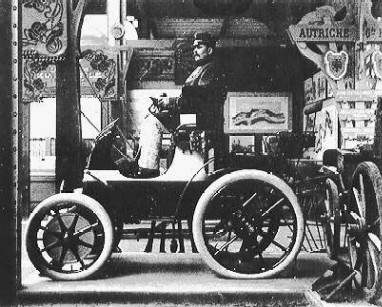 This is the "System Lohner-Porsche" petrol-electric car built in 1899 by Ludwig Lohner and Ferdinand Porsche and which was exhibited in 1900 at the Paris Exposition Universelle. Note the front-wheel hub motors.
This is the "System Lohner-Porsche" petrol-electric car built in 1899 by Ludwig Lohner and Ferdinand Porsche and which was exhibited in 1900 at the Paris Exposition Universelle. Note the front-wheel hub motors.
![]() Go now to Part 3
Go now to Part 3
![]() Return to Start
Return to Start